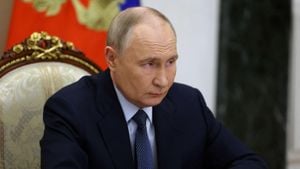Global markets have been abuzz with reactions following the recent appointment of Scott Bessent as the new U.S. Treasury Secretary. Investors are eager to understand how his policies might shape the economic environment, and markets have begun to move accordingly.
Gold prices, often seen as a safe haven during turbulent times, dipped by 2% after this announcement. While previous sessions showed signs of optimism, with gold rallying to three-week highs, profit-taking has led to recent losses. Prices hovered just above the 50-day moving average, indicating how sensitive the market is to changing sentiments around economic stability.
Market analysts noted the significant factors contributing to this shift. Bessent’s background suggests he may pursue fiscal policies aimed at stabilizing economic growth, potentially curtailing inflation risks associated with aggressive trade policies. The market reacted positively to the indication of reduced trade tensions, which appears to have diminished the immediate demand for gold as a protective asset.
Simultaneously, traders are keeping their eyes peeled for upcoming economic data releases, such as the Federal Reserve minutes and GDP revisions. The anticipation around these reports stems from speculation about interest rate adjustments. According to data from CME FedWatch, there is about a 56% probability of the Fed reducing rates by 25 basis points this December.
Meanwhile, the broader equity markets reflect changing investor sentiment. The S&P 500 index has been on the rise, supported by bullish expectations of corporate earnings and economic indicators. This uptick is backed by optimism around pro-business policies, particularly as the new Treasury Secretary was appointed. All eyes were on market indices, as financial data, like the Composite PMI which recently showed improvement, brought hopes of sustained economic expansion.
The labor market indicators also played their part. The latest data depicted steady job growth, reinforcing narratives around consumer spending, which is pivotal for keeping the economy afloat. The combination of positive labor trends and market readiness to adapt to new policy directions laid the groundwork for potential stability moving forward.
Traders leaned toward equities, boosting market indices as the demand for gold waned. Lower Treasury yields, spurred by lower expected inflation, complemented this movement, making gold less appealing compared to stocks. The softening of the dollar offered additional support for equity markets, as international investors could find U.S. assets more attractive.
Bessent stands out among his predecessors for his approach, which emphasizes moderation over aggressive fiscal interventions. His nomination sent ripples through both the gold and stock markets, where traders assessed the impact of his pro-business stance against inflationary expectations. Some forecasted potential shifts as more clarity surrounding U.S. fiscal policy emerges under his leadership.
Additional pressure on commodities, particularly oil, also contributed to volatility. Oil prices were observed straddling key support levels, as geopolitical calm suggested fewer disruptions to supply. The oil market is often sensitive to economic shifts, with any sign of instability prompting price adjustments.
Looking forward, the dynamics surrounding Bessent’s policies, along with significant data releases, could lead to unpredictable shifts within the global markets. Investors are gearing up for potential re-adjustments as they navigate the intersection of political change and economic data. The interplay between these factors will likely define market stability or volatility leading up to the end of the fiscal year.
Overall, the market's reaction to Scott Bessent's nomination as Treasury Secretary has set the stage for intriguing developments. How this plays out could offer more than just short-term fluctuations—it's about setting the trends for the months to come. With upcoming economic reports expected to provide more substantial data, traders remain vigilant as they chart the course of the market. How will these changes reshape investment strategies? Only time will tell, but the groundwork for volatility and opportunity has definitely been laid.



